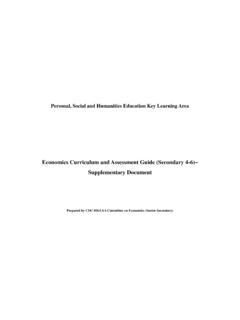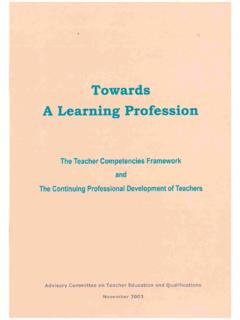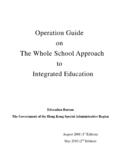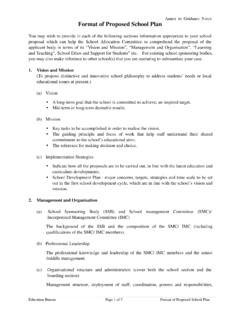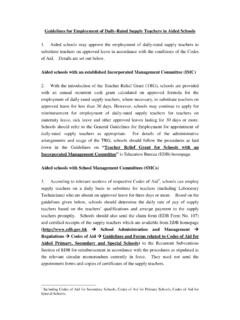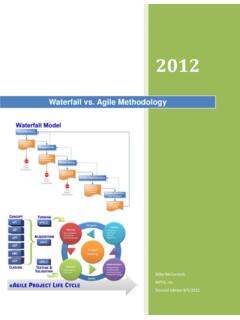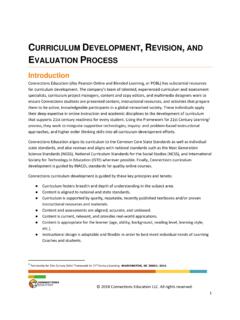Transcription of Learning English through Drama - Education Bureau
1 EDB Language Arts ElectivesProfessional Development for TeachersLearning English through DramaEDB Professional Development for TeachersBritish Council Hong KongTeaching English through Drama1 EDB 2008 / 2009 EDB Language Arts ElectivesProfessional Development for TeachersLearning English through Drama1 Teaching DramaIn part 2 of the workshops we experienced two demonstrations. In this section we review the two teaching sequences and consider the stages, aims and range of activities available for developing English skills through A Structured Approach to Teaching DramaTeaching Drama to large groups places a number of demands on the teacher. When teaching Drama we can expect: a fairly high level of conversational noise different groupings, with students standing, moving, sitting, and using space to express themselves different groups working at different paces towards different goalsIn the workshop we addressed the fact that learners may not be confident about their English , or may think that Drama is just fun and teachers we are aware that the main aim of this module is to develop students language skills not produce actors or actresses.
2 For this reason we need to carefully structure our lessons so that they have clear linguistic and skills-development aims, and to communicate these aims clearly to students so that are clear on what is expected of demonstration 1 we saw that it was important to have clear language aims for lessons. We also saw that a generic structure for a lesson should contain a focus on aims and expectations, warm up activities which target language as well as performance aims, a context such as a story within which to develop the Drama , a range of Drama conventions which focus on skills such as character building, expressing emotion through voice and movement and, of course, creativity and confidence with language.
3 Lessons, or series of lessons, should provide opportunities for students to reflect on their progress and to identify areas for further development. demonstration 2 illustrated the process of moving from story to script and we saw how a number of different performance-based activities could be incorporated into lessons. The EDB scheme of work offers many options for teachers in terms of the type of performance-based work they do within the Drama module. Schools could, for example, adapt their class reader or use a prepared script that students can then personalise by editing and adding. Key Drama skills developed in this process involve characterisation and staging conventions. In the workshop, we worked through a series of tasks which focussed on these skills, while still being focussed on language skills two of the scheme of work allows students to develop, amongst others, their writing skills.
4 Script writing has a number of conventions which students need to be aware of. But the fact that writing dialogue is often easier than, for example, writing a story, even lower level students will be able to achieve something they can feel proud of, given the right support from the EDB 2008 / 2009 EDB Language Arts ElectivesProfessional Development for TeachersLearning English through demonstration 1 Lesson Plan and ResourcesLesson plan: A Structured Drama Class1 Establishing the focusAims: To ensure students are clear on the Learning objectives and what is expected in terms of behaviour and organises starting circle and agrees on the aims of the lesson. Elicit words beginning with C, communication, co-operation, creativity, content, Check spelling and write on the spaceAims: To encourage learner autonomy and responsibility.
5 To ensure students have a defined work up groups and assign performance Materials: 1 set of word cards / 4 or 5 students Aims: To introduce and provide practice with key vocabulary. To develop range of expression through movement and encourage collaboration / co-operationIntroduce the vocabulary by showing the word cards and checking students understand the SculpturesIntroduce by demonstrating with a student. You are a sculptor; the student is the sculpting materials. Move the student to make the object (chair) written on the card. Check students understand what to do: if necessary, get a pair of students to demonstrate for the work in groups of 5 or 6, the word cards are face down.
6 One student selects a card and sculpts their partner to form the object. They could use sound effects and movement as well. The rest of the group watch and try to guess the correct word on the of waterChairMobile phoneScissorsTrainFirefighterExample A: Word Cards for Human Sculptures3 EDB 2008 / 2009 EDB Language Arts ElectivesProfessional Development for TeachersLearning English through Drama4 Using Stimuli Materials: 1 set of picture cards / 4 or 5 studentsAims: To further develop language skills in the context of a narrative. To encourage creativity and confidence with English through developing a group that all the words in the last activity relate to a true story about a teacher.
7 Show big pictures on the work in groups to match words to pictures. T checks answers, sticking the word cards next to the correct pictureIn groups, students orally create a basic story in groups, using the pictures. They tell the class. Check ideas by re-ordering the pictures and words on the board. Ask other groups to say if their story is the same or different if time allows, ask another group to tell their work Materials: Sentence word cards (jumbled order on the board)Aims: To develop range and control of pronunciation. To learn about the effect of voice on creating a character. To introduce a system of notation to learners for further voice clarifies the story for students: This story is about a young teacher, Kate.
8 It is Saturday morning and she doesn t have to go to work. She is going to a hairdresser on Lantau. When she is there, she gets a phone call which changes her day for the worse! T sticks the jumbled word cards on the board. Explain that this is what Kate said when she received the phone call. Give students time to try and reorder the words to make the correct sentence. Elicit suggestions from students and rearrange the cards on the board. Check meaning and students copy the sentence. Well, I m really not sure that that is going to be possible! T works with the students on pronunciation (show students how to annotate using symbols). Make a note of the decisions made about the character s voice in relation to: word / sentence stress (draw dots over words to indicate stress) pausing (use // to indicate any pauses) accent (British?)
9 American? Hong Kong?) speed (fast? Slow?) (Use an arrow under phrases that are spoken quickly and a dotted line under slow sections) volume (loudly? softly? whispered?) (write the words on the text) intonation (use arrows to indicate direction) pitch (high? low?) (underline high pitch, draw a line over low pitch)Additional practiceDictate a different, longer piece of speech possibly a short dialogue between Kate and the hairdresserStudents work in pairs to decide how to say the sentence. They annotate their script, using the conventions above. In open class, students deliver their lines. Talk to the class about how each one sounds, high or low pitch, stressed words, speed, etc.
10 4 EDB 2008 / 2009 EDB Language Arts ElectivesProfessional Development for TeachersLearning English through DramaWith more advanced groups, ask students about how the voice can help create a character, does the character sound young or old, what is her background, did she go to university, what kind of a person is she? 6 Sound collage Aims: To provide opportunities for creativity, suitable to mixed level groups. To emphasise the importance of sound and sound effects in creating Drama . T works with the class. Give students time to brainstorm the different things you can hear at a hairdresser a range of sounds that we can hear in the location (a hairdresser s) T. writes up ideas on the board.
